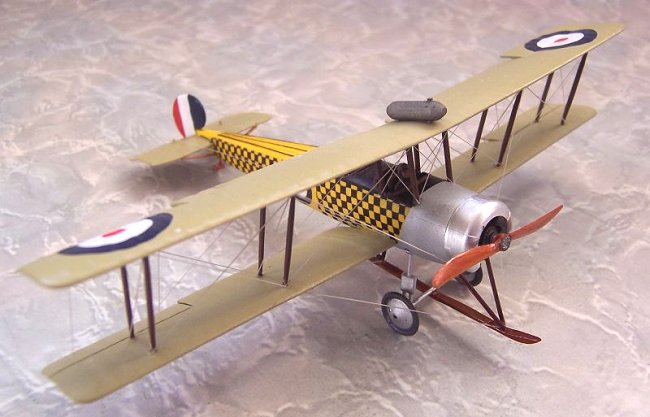
Airfix 1/72 Avro 504
|
KIT # |
1048 |
|
PRICE: |
$ |
|
DECALS: |
Two options |
|
REVIEWER: |
Mark Fordham |
|
NOTES: |
Home made decals used |

|
HISTORY |
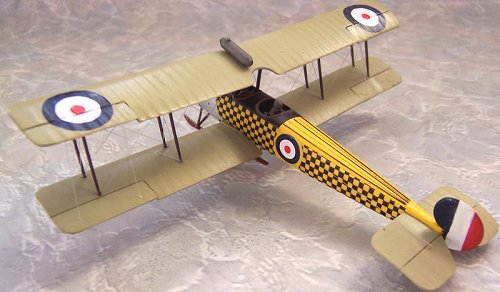 The
Avro 504, a lightweight, two-seater aircraft, was designed by Alliot
Vernon Roe in 1913. It was an easy plane to fly and was used in the early
stages of the war for light-bombing and reconnaissance missions. When a
Avro 504 was shot down on 22nd August, 1914, it became the first British
casualty of the war. Three Avro 504 were used to bomb the Zeppelin
factory at Friedrichshafen. However, the Avro 504 was not a successful
combat aircraft and they were withdrawn from the Western Front at the end
of 1914.
The
Avro 504, a lightweight, two-seater aircraft, was designed by Alliot
Vernon Roe in 1913. It was an easy plane to fly and was used in the early
stages of the war for light-bombing and reconnaissance missions. When a
Avro 504 was shot down on 22nd August, 1914, it became the first British
casualty of the war. Three Avro 504 were used to bomb the Zeppelin
factory at Friedrichshafen. However, the Avro 504 was not a successful
combat aircraft and they were withdrawn from the Western Front at the end
of 1914.
A new version of the Avro 504B was produced early in 1915. This was a
single-seater and this enabled the aircraft to store extra fuel and take
part in long-range reconnaissance missions. It was also hoped that the
Avro could be used against Zeppelins when they bombed Britain. This Avro
was withdrawn from front-line action during the summer of 1915 and for
the rest of the war was used as a training aircraft. A total of 8,340
Avro aircraft were built during the war and it remained in service as an
RAF trainer until 1924.
|
THE KIT |
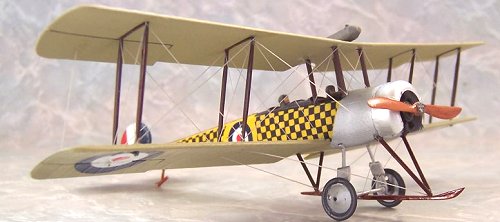 The
Airfix Avro 504K is like most of the Airfix moulds and getting very long
in the tooth these days in fact it has been around longer than I have.
This particular incarnation was locally injected, produced and marketed
right here in New Zealand by Lincon toys, back in the days when a lot of
Airfix moulding was done in Auckland. Not that there was a lot to mould
on this particular aircraft as like most Airfix offering dating from this
time is very basic in parts and decals, just the way I like them!
The
Airfix Avro 504K is like most of the Airfix moulds and getting very long
in the tooth these days in fact it has been around longer than I have.
This particular incarnation was locally injected, produced and marketed
right here in New Zealand by Lincon toys, back in the days when a lot of
Airfix moulding was done in Auckland. Not that there was a lot to mould
on this particular aircraft as like most Airfix offering dating from this
time is very basic in parts and decals, just the way I like them!
Decals are for two machines, but from past experience I knew that these locally printed decals would not have stood the ravages of time terribly well. And would break apart at the first sniff of water.
|
CONSTRUCTION |
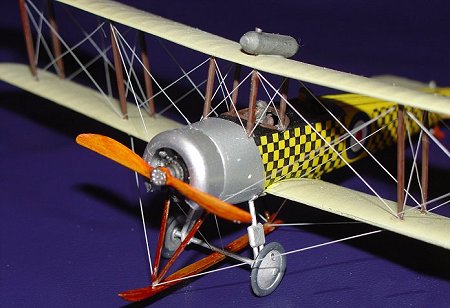 Assembly started with gluing the fuselage halves together, what no
cockpit detailing I here the superdetailers groan? ..why bother building
all that detail for the cockpits when they are going to be completely
filled by two pilots, yup for the first time ever I decided to include
the pilot figures in one of my planes.
Assembly started with gluing the fuselage halves together, what no
cockpit detailing I here the superdetailers groan? ..why bother building
all that detail for the cockpits when they are going to be completely
filled by two pilots, yup for the first time ever I decided to include
the pilot figures in one of my planes.
Now everybody who knows anything about the Avro 504 knows that Airfix got the fuselage wrong, it being too shallow in depth and about 3mm too short, now I decided that I wasnít up to scratchbuilding a complete new rear fuselage so left it be and decided to concentrate this build on trying new decaling techniques.
With the fuselage together and the lower wing joined it was time to add a few little extra detailing items, the few panel lines were rescribed and ribs were added along the rear of the fuselage.
|
COLORS AND MARKINGS |
With
WWI biplanes it is always a good idea to paint the aircraft prior to
adding the top wings so this point it was time to head off to the paint
shop. Now both version the Airfix supplied in decal form were to say the
least pretty boring and I really liked the 1/48th 504 that
Candice Uhlir did right
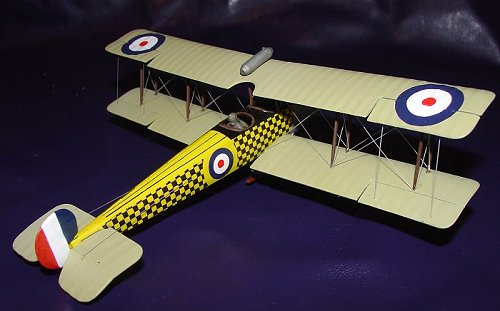 here on MM for a look at that very
impressive build click here this yellow and black chequered
bumblebee really looks colourful.
here on MM for a look at that very
impressive build click here this yellow and black chequered
bumblebee really looks colourful.
How to recreate the same thing in 1/72nd scale, hmmm no decals available in my next of the woods, sigh looks like itís time for a bit of kiwi ingenuity again, first step was to paint the fuselage Tamiya yellow, about 5 coats were needed to give good colour depth over the gray and primer, once the yellow had set hard the black anti-glare panel was masked off and sprayed. The aluminium doped panels were sprayed using Tamiya flat aluminium and the cowling was sprayed with the last remaining dregs of my Alclad II.
With the main painting out the way it was time to turn my attentions to reproducing the black cheques on the fuselage. Now, I cant get clear decal paper easily and I had in the past experimented with the clear decal areas around the cheap and tacky bathroom tile decals available in all good hardware shops. The decal film of these tiles is rather thicker than kit decals and hadnít in the past been of much use until I discovered that my homemade decal softener really liked the tile decals and snuggled them down almost as good as top band decals.
 Armed
with a couple of usable clear decal strips 1 inch by 3 inches long I
first used Paintshop pro to design the black/clear chequering on the
computer, once I was happy with the size the chequering was printed out
first onto white paper using a HP 1200 Laserjet printer, the clear decal
strips were then taped over the paper printed design and run through the
printer again. I ended up printed two strips per side to allow for my
inevitable screw-ups. First thing that was applied was the fuselage
roundels from the spares box as this gave me a positioning guide for the
chequering. Using paper masks I then cut the homemade Chequer to size and
applied as per a normal decal, once I was happy with the fit and position
of the decals I hit it with my homemade decal softener @ about 44% acetic
acid which is about 10% stronger than the normal evil brew I use.
Armed
with a couple of usable clear decal strips 1 inch by 3 inches long I
first used Paintshop pro to design the black/clear chequering on the
computer, once I was happy with the size the chequering was printed out
first onto white paper using a HP 1200 Laserjet printer, the clear decal
strips were then taped over the paper printed design and run through the
printer again. I ended up printed two strips per side to allow for my
inevitable screw-ups. First thing that was applied was the fuselage
roundels from the spares box as this gave me a positioning guide for the
chequering. Using paper masks I then cut the homemade Chequer to size and
applied as per a normal decal, once I was happy with the fit and position
of the decals I hit it with my homemade decal softener @ about 44% acetic
acid which is about 10% stronger than the normal evil brew I use.
With the fuselage decals down and sealed the wings and tailplanes were treated to a coat of Humbrol Linen and set aside to dry.
The only decals that I had to leave off was the white serial numbers as white is one colour that I can not print and Iím completely out of spare white numbers from the decal stash and in situations like this the model will remain unfinished until the time I come across the correct lettering codes.
|
FINAL CONSTRUCTION |
Turning my attention to the wooden props I decided to call in the help
of some of my Internet buddies who are vastly better modelers than I am.
My mate RR suggested I use the clear orange, clear yellow over tan
process to recreate the wood grain effect on the propeller and
undercarriage, Thanks to a very detailed email from RR I was able to get
a passable wood finish on only my 2nd attempt. With most of
the painting and decaling done it was time for the bit I really dread
with them two  winged thingies, attaching the top wing to those tiny
little struts. Using makeshift jigs out of paint bottles card and bluetack I managed to get the top wing straight and true before hitting
it with a couple of drops of superglue to tack the wing in place. Once
the CA had dried I went back and did the rest of the struts with MEK to
make sure they were going to stay put. (Iím a really clumsy modeller).
winged thingies, attaching the top wing to those tiny
little struts. Using makeshift jigs out of paint bottles card and bluetack I managed to get the top wing straight and true before hitting
it with a couple of drops of superglue to tack the wing in place. Once
the CA had dried I went back and did the rest of the struts with MEK to
make sure they were going to stay put. (Iím a really clumsy modeller).
With the top wing perched atop those very thin struts just waiting to be wiped off it was time to tackle the undercarriage, now the 504ís undercarriage looks rather complicated but goes together surprisingly easy with no major dramas.
The 504 was looking almost finished by this stage and just needed the addition of the rigging, pilots and wheels to complete it. The rigging was added using stretched light gray sprue and affixed with drops of MEK, just like the real plane the addition of the rigging really tightened up and strengthened the top wing.
Now the real aircraft had wire spoked wheels and these would be almost impossible to reproduce in 1/72nd scale so I cheated and painted the Airfix supplied wheels silver with dark gray rubber, the prominent tank on the top wing of the 504 was badly formed in my example so I chucked a length of sprue in my cordless drill and used it as a lathe to carve a new one, added the pilots and buzzed the cat on the way to the finished model shelves.
|
CONCLUSIONS |
Yet another Airfix model added to my collection and shock horror a WWI one at that, Iím on a bit of a WWI kick at the moment and are delving into an area of aviation history that is fascinating. Okay Airfix got it wrong with the accuracy of the 504K but if you can live with that fact these old classics can build up into interesting and colourful subjects with a little bit of time and effort.
The Airfix 504 cost me $2.00 from Trademe (ebay clone) and the tile decals cost $1.95, so for an outlay of $3.95 I had three weeks of modelling fun, with the average DVD rental running at about $8 per night the 504K was cheap entertainment in my book.
|
REFERENCES |
Googling 504K
http://www.modelingmadness.com/reviews/w1/uhlir504.htm
and yes I know itís a model of a model!
April 2004
Copyright ModelingMadness.com
If you would like your product reviewed fairly and fairly quickly, please contact the editor or see other details in the Note to Contributors.